

PeerCohort ProgramPlaybook
College Transition Support


ASummer MeltSolution

AboutThis guide was developed in partnership with United for College + Career Success and the TxCAN Effective Practices team.
The Peer Cohort Program Playbook is a resource designed to guide two-year and four-year colleges in establishing peer cohort programs. These programs aim to create strong, supportive communities that foster connection, engagement, and academic success. The playbook compiles strategies, best practices, and actionable steps that institutions can use to foster collaborative, resilient peer networks for incoming students transitioning from high school to college.
TABLEOF CONTENTS
02 03 09 14 20 25
OVERVIEW
LAUNCHING A PEER COHORT PROGRAM
RECRUITMENT STRATEGIES AND GUIDE
PROGRAM OUTREACH TOOLKIT
PROGRAM EVALUATION & SUCCESS
CONCLUSION AND NEXT STEPS
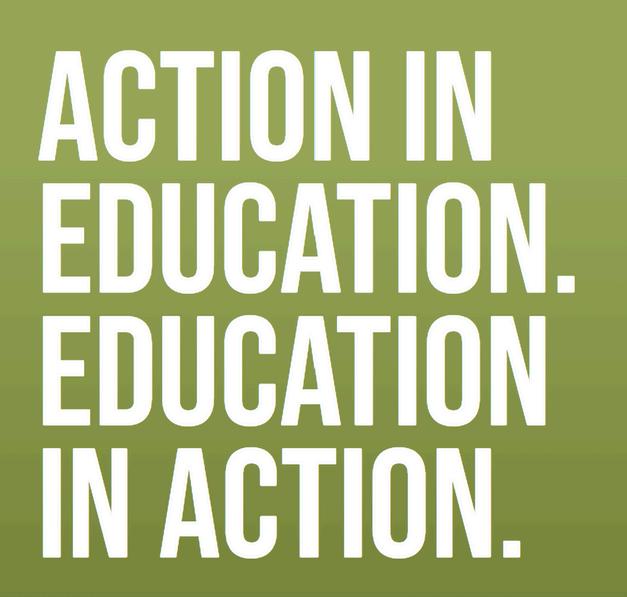
Encouraging Innovation in College Access with Effective Advising Practices
The Texas College Access Network (TxCAN), an initiative of Educate Texas, unites state agency leaders, regional education coalitions, college access nonprofits, and funders to collaboratively reduce barriers to college access. To promote the implementation of innovative and effective practices, TxCAN established the Effective Practices Project Team In 2023, the team launched its inaugural Pitch Competition in partnership with the National College Attainment Network (NCAN), during their National Conference. The competition awarded a $5,000 stipend to the winning team to advance their impactful work in college access
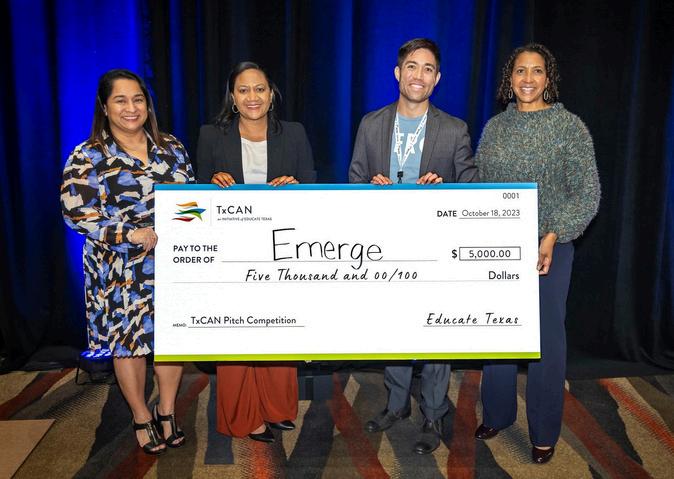

EMERGE, the winner of TxCAN’s 2023 Pitch Competition, is dedicated to empowering highperforming students from underserved communities to attend and graduate from selective colleges and universities nationwide. Their winning pitch highlighted the SQUADS program, a standout initiative addressing summer melt, boosting student persistence, and tackling capacity challenges in the transition to higher education The program connects students from five Houston-area school districts with upper-level students at their chosen colleges, fostering mentorship, guidance, and a sense of community during the crucial transition from high school to college.
The SQUADS program has achieved remarkable results, with an 87% of program completers student persistence rate well above the national average of 76%. This innovative model leverages peer-to-peer support through trained SQUAD coordinators, who mentor first-year students and organize social programming to build community By addressing logistical challenges, providing guidance, and cultivating a culture of mentorship, SQUADS not only enhances student success but also expands EMERGE’s capacity to deliver personalized support TxCAN is thrilled to highlight the SQUADS program as a scalable, impactful model to improving college matriculation and retention, paving the way for transformative change in higher education access
The College Transition Peer Cohort Playbook draws inspiration from the EMERGE SQUADS program and synthesizes promising practices from other successful peer mentoring initiatives. Programs interviewed include College Possible’s Catalyze near-peer coaching program, Young Women’s Preparatory Network (YWPN) Scholars Program, The Posse Foundation, and Lee College’s First-Year Experience (FYE) peer mentoring program Additionally, this playbook is informed by related research to provide a comprehensive guide for developing effective peer cohort programs.
Dr. Emily Calderon Galdeano, TxCAN Guiding Team Chair; Shareea Woods, TxCAN Director; Gary Tashima, Pitch Competition Winner; Natalie Williams, Effective Practices Project Team Chair.
LAUNCHING A PEER COHORT PROGRAM
Bridging the Support Gap for Underserved Students



PLAYBOOK
The playbook is designed to guide the creation and implementation of peer cohort programs (a group of students who support each other academically and socially) lead by a “peer leader" who facilitates and nurtures this supportive environment. By providing a clear, step-by-step framework, it simplifies the process of starting and maintaining these programs, fostering a sense of community and collaboration among students.
WHAT’S INSIDE
Program Launch Milestones: An overview of 10 key milestones for launching a successful peer coaching program
Timeline: A high-level program timeline that provides an ideal flow of a college transition support peer cohort program
Recruitment Strategies: Effective approaches for identifying and attracting a diverse, committed cohort of student participants.
Outreach Toolkit: Designed to provide ready-to-use, customizable resources to effectively promote and engage students in the Peer Cohort Program.
Program Evaluation: Tips and methods to assess the program’s impact, ability to drive continuous improvement for student success, and demonstrate value through datadriven outcomes.
Hyperlinks: The beginning of each section includes icons that are clickable For print versions, page numbers are listed.
10KeyMilestones|07
RecruitmentGuide|09
OutreachToolkit|13
ProgramEvaluation|18
KEY MILESTONES FOR LAUNCHING A SUCCESSFUL PEER COACHING PROGRAM
Define Objectives and Goals
What are the key goals for a successful college transition program? Examples may include improving academic performance, fostering community, or providing mentorship. Program goals should align with existing institutional goals Secure
Institutional Support
Gain approval and support from college administration

Form a Planning Committee
Identify the primary staff member responsible and assemble a cross section of faculty, staff, and students to help design and implement the program.
Secure partnerships with high schools or community organizations that work with high school seniors. Involve legal or appropriate departments if minors are participating in the program. Present your objectives, benefits, and a foundational plan to key stakeholders
Develop a Recruitment Strategy
Create a plan to recruit both cohort leaders and students
Use flyers, social media, email campaigns, and information sessions to spread the word.
Design Training Programs
Develop comprehensive training for peer leaders. Include topics like communication skills, conflict resolution, and program expectations.
Set Selection Criteria
Establish clear criteria for selecting peer leaders. Consider qualities like leadership skills, academic performance, and interpersonal abilities
Match Cohorts
Pair or group selected program participants with peer leaders based on interests, academic goals, availability, and student’s intended major. Aim for balanced and supportive cohorts.
08.
Plan Meetings & Activities
Have peer leaders schedule regular meetings for cohorts to interact. Plan activities that promote bonding, academic support, and personal development. Include staff with both formal and informal events (e.g. coffee study sessions, pizza nights, career fairs, or networking events).
Implement a system to track the progress and effectiveness of the program. Use surveys, feedback sessions, and performance metrics to gather data and make improvements
Acknowledge the efforts and achievements of participants and peer leaders. Host events or ceremonies to celebrate milestones and provide certificates or awards
Celebrate Successes
Ideal Transition Support
Peer Cohort Timeline
March
Begin Recruitment:
Start recruiting peer leaders from current college students and peer cohort groups from current high school seniors.
May Launch Program: Match Cohorts:
June
Officially kick off the peer cohort program with an introductory event. Implement a system to track the program's progress and gather feedback.
Pair participants with peer leaders, prioritizing matching based on interests and goals.
April Design Training & Recruitment:
Continue recruiting peer cohort groups and train peer leaders.




Students who participate in peer mentoring programs are more likely to achieve higher grades and report greater satisfaction with their college experience? It's a win-win for everyone involved! (Burton et al., 2021)
July Guide Program:
Remind peer leaders to schedule meetups and sessions with their own cohorts.
October
Mid-Semester Check-in:
Conduct a formal check-in with cohorts to assess progress and address any issues.
November
End-ofSemester
Events:
Plan events to celebrate the program's successes and recognize participants.
Aug / Sep
Activities:
Ensure that meetups are being held. Make any necessary adjustments to meetings and activities based on initial feedback.
December
Celebrate & Plan for Next Semester:
Host a closing ceremony, collect feedback, and plan for the continuation of the program depending on planned program duration.

RECRUITMENT GUIDE
Strategies for Assembling the Right Mix of Student Leaders and First Year Students

RecruitmentGuide|10
Cohort Selection | 11
Cohort Leader Training | 12
Advertisement | 13
3KeySteps forEffective Cohort Recruitment

1
2 IDENTIFY TARGET GROUPS CONDUCT OUTREACH
Underserved Groups: Focus on students who may not have equal access to resources and opportunities
First-Generation Students: Identify students who are the first in their families to attend college, as they often face unique challenges.
Students Needing Extra Support: Reach out to students who may require additional academic, social or financial support to thrive in their educational environment.

The most important and sometimes challenging part of starting a mentoring program is actually recruiting students. Here are three key steps to recruit students for your program.
Email List: Compile a comprehensive list of potential partnerships through school databases, student organizations, and academic advisors.
Platforms: Utilize popular social media platforms such as Instagram, Twitter, Facebook, and LinkedIn to spread awareness about the peer mentoring program.
Content: Craft a compelling email with a clear callto-action, inviting students to sign up for the peer mentoring program Highlight the program's benefits, application process, and deadlines
3
COLLABORATION WITH HIGH SCHOOL COUNSELORS & ADVISORS
Personal Recommendations: Work closely with student advisors to identify and recommend students who would benefit from the program based on their academic backgrounds and personal needs.
Workshops and Info Sessions: Organize workshops and information sessions where advisors can present the program to students and answer any questions they may have
One-on-One Meetings: Encourage advisors to hold one-on-one meetings with students to discuss the program in detail and assist with the application process

Cohort Leader Recruitment
Select cohort leaders from upper classmen or transfer-ready community college students who have successfully navigated the firstyear experience.
Recruit 1 cohort leader per 8-20 students to manage resources effectively, targeting larger cohorts for peer support.
For cohort leaders, emphasize the career advancement, academic support, and leadership development that students will gain by joining the program, specifically designed for college students who may be juggling work, family, and education.
To encourage participation and commitment, offer performancebased stipends, leadership awards, access to professional networking, internship opportunities or academic credit for cohort leaders.

Provide a central hub for cohort leaders to access essential information. Set up an online resource hub (e.g., Dropbox, Google Drive) where they can find everything from mental health resources to campus maps. Ensure it's interactive and mobile-friendly, incorporating chat features or a FAQ section.
TrainingPeerCohortStudentLeaders
Comprehensive training will help cohort leaders feel confident and ready to support transitioning students. These leaders play a crucial role in maintaining communication, sharing important information, encouraging participation in workshops, and providing cohort leadership. By focusing on the following five key areas, we can equip them with the skills and tools they need to succeed:
Roles and Responsibilities
Clearly define leaders' roles and ensure they have access to resources to guide students on issues beyond their scope of work. See sample on next page.
Effective Communication
Train leaders to communicate effectively through group chats and social media, emphasizing active listening and clear messaging
Digital Tools
Introduce and provide hands-on training for digital tools that facilitate group communications and track engagement such as Slack, Microsoft Teams, Zoom, Google Meet, and Discord.
Encouraging Participation
Teach leaders how to create engaging content, ask open-ended questions, and recognize student achievements to foster active participation.
Peer Mentorship
Provide training on building trust, offering support, and giving constructive feedback to help mentors be more effective.

WEARE HIRING!
Applyby[Date]
KEYRESPONSIBILITIES
CreateandMonitorGroupChat: Facilitatecommunication,provide support,andsharehelpfultips
PromoteEventsandActivities: Informandencourageparticipation inbeneficialeventsandworkshops.
ProvideSupportandGuidance: Offeradviceonacademic,social, andpersonalmatters.
ConnectStudentswithResources: Directstudentstocampus resourcesforissuesbeyondthe peerleader'sscope
ROLEOVERVIEW
ThePeerCohortStudent Leaderisanupperclassman responsibleforsupporting first-yearstudentsasthey transitionintocollegelife.This roleinvolvesproviding guidance,fosteringasenseof community,andconnecting studentswithresourcesto ensureasmoothand successfulfirstyear.
EXPECTATIONS
Maintainconfidentialityand respectstudents'privacy. Demonstrateempathy,patience, andapositiveattitude. Beproactiveinidentifyingand addressingtheneedsofthe cohort.
Regularlycommunicatewiththe cohortandprovideconsistent support.

Toolkit&CommunicationTips

Welcome to the Ready-to-Use Resources for Effective Student Engagement! This section provides a variety of templates designed to help you engage with students effectively. You can easily customize these templates using Canva to suit your specific needs and preferences. Additionally, you have full permission to use and modify the images included in these templates. Feel free to get creative and make these resources your own!
5 Tips to Engage & Connect
Craft Catchy Subject Lines: Grab their attention right from the inbox with intriguing and relevant subject lines. Use questions, humor, or a sense of urgency to make them want to open your message.
Include Clickable Links: Make it easy for students to access important information by embedding clickable links in your messages. Use clear call-to-action phrases like “Learn More,” “Sign Up Here,” or “Join the Event” to guide them directly to the content they need.
Use Emojis: Emojis can make your communication more relatable and engaging. They add a personal touch and can help convey emotions or highlight key points.
Keep It Visual: Incorporate images, GIFs, and videos to make your messages more dynamic and appealing. Visual content can break up text and make your communication more memorable.
Personalize Your Messages: Address students by their names and tailor your content to their interests and needs. Personalized messages show that you care and are paying attention to their individual journeys. 2 1 3 4 5

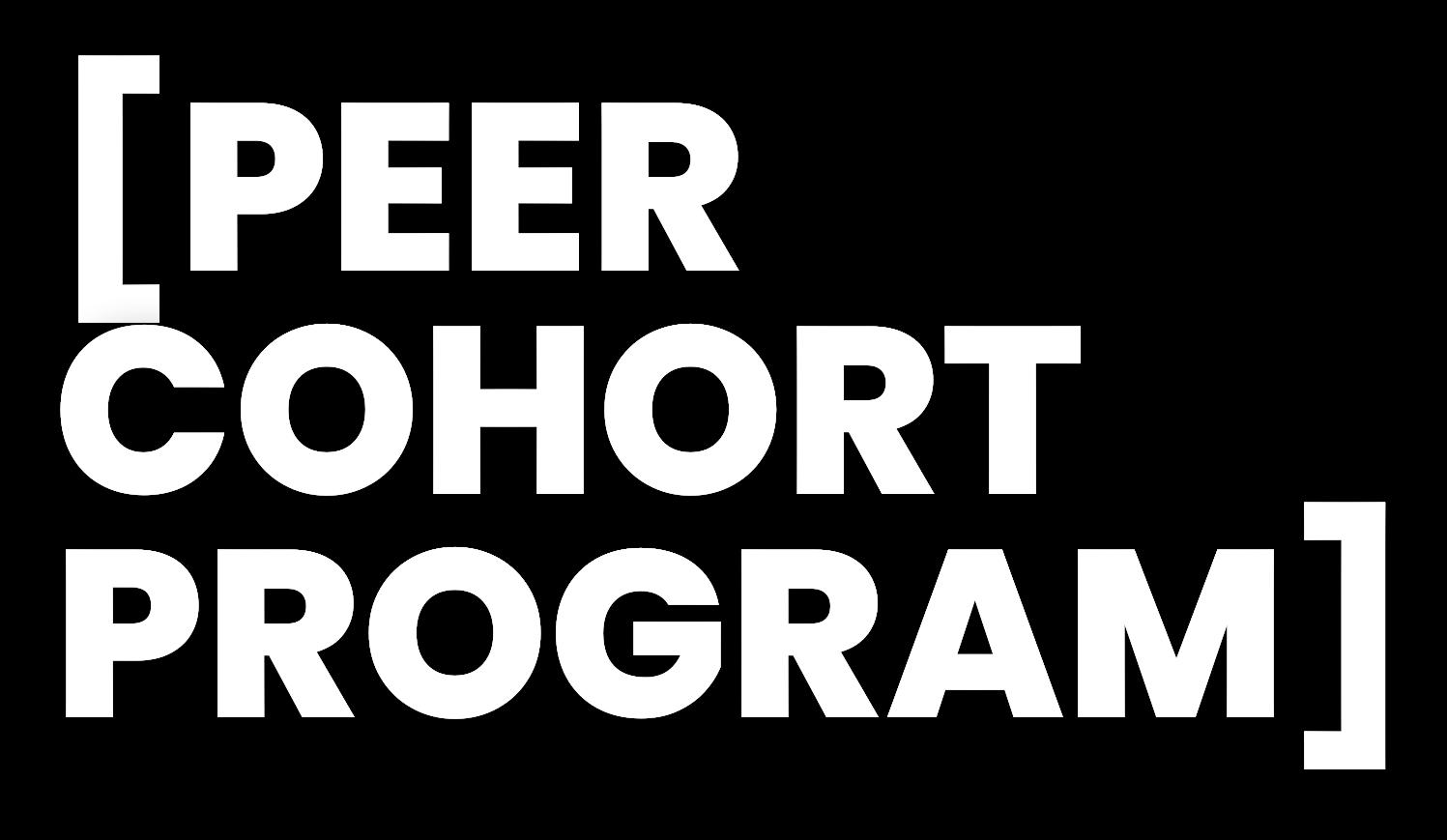
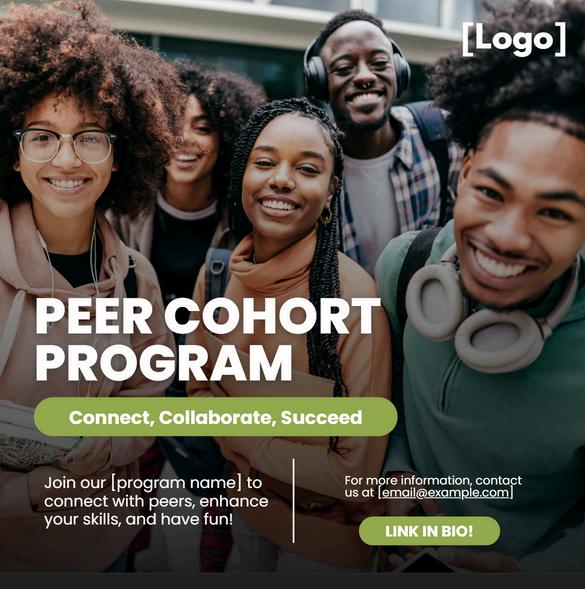
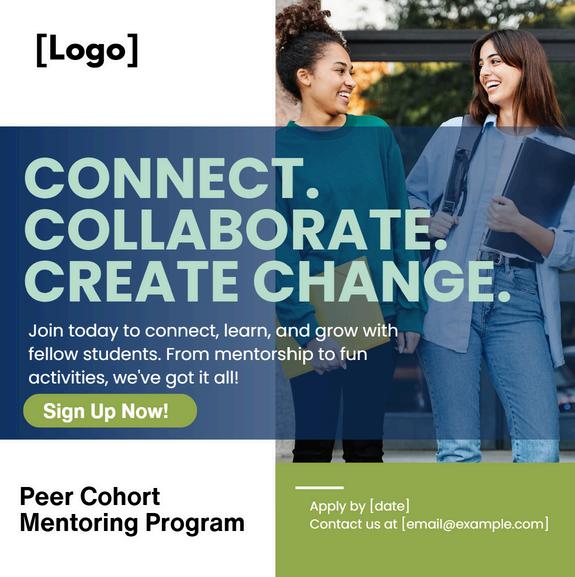
STUDENT INTEREST REGISTRATION FORM

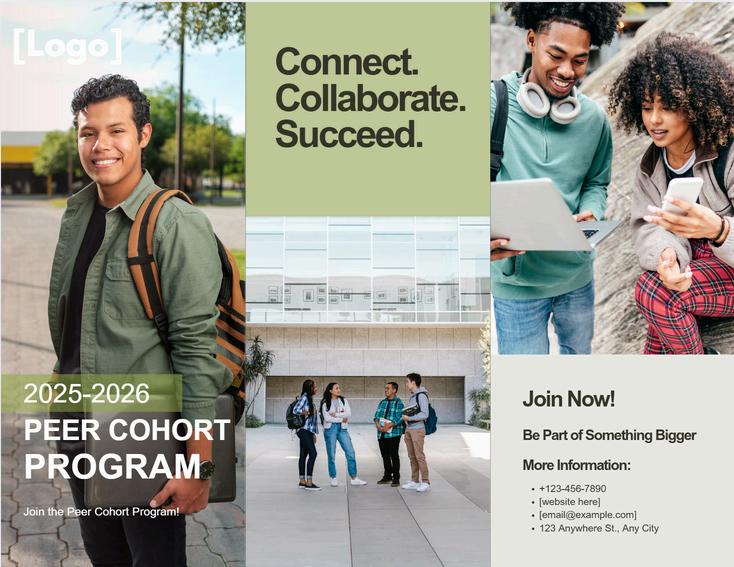
Click here to edit


Data&ProgramEvaluation

A critical component of program sustainability and improvement is data capture. This section provides data tracking methods, outlining key performance indicators (KPIs), as well as data collection tools. We recommend you measure student engagement, emotional well-being, and program impact throughout the transition to college.
Timeline for Data Collection
End-of-Program Evaluation: Review student outcomes - successful enrollment, retention, and program engagement. 2 1 3 4
5
Pre-Program: Collect baseline demographic, academic, and emotional well-being data for students and cohort leaders. It’ll create the benchmark for measuring changes over time and provide insight on who is benefiting most from the program.
Summer Transition & Successful Enrollment: Track attendance at onboarding events and meetings, as well as student feedback on satisfaction with the support received. Track student enrollment data.
Quick Monthly Pulse Checks: Send out brief text-based surveys to gauge students' connection to peers, and whether they are accessing support when needed. Keep surveys short and offer fun graphic links (GIF's, interactive icons, celebratory effects (confetti, sound effects)) as rewards for completing them. You can use AI-driven texting platforms to automate responses based on feedback.
During the Program: Keep participation records and track engagement to identify at-risk students early. Consider using the Mentors’ Perceived Program Support Scale (MPPSS) to identify cohort leaders who may need additional support.
Timeline for Data Tracking and Survey Distribution
4.1. Pre-Program (Spring of Senior Year)
March - April:
Student Pre-Program Data Collection: Capture demographic and academic data.
Program Manager Data Collection: Gather demographic and experience-related information for program managers.
4.2. Summer Transition (June - August)
June:
Summer Participation Tracking: Begin tracking student attendance at summer onboarding meetings and events.
Pulse Check Survey (Monthly/Bi-weekly): Distribute short engagement surveys to monitor student excitement, preparedness and readiness for college.
4.3. Fall & Spring
(Sept - May)
May:
Baseline Emotional Well-being Survey: Administer pre-program Social Emotional Learning survey to students (see SEL survey sample on next page).
July:
Emotional Well-being Survey: Conduct a quick emotional well-being check.
Pulse Check Survey (Monthly/Bi-weekly)
August:
Pulse Check Survey (Transition Survey): Send out a survey to assess how prepared students feel for the fall semester (e.g., financial, academic, and emotional preparedness).
WEEKLY PARTICIPATION TRACKING
PULSE CHECK SURVEY
EMOTIONAL WELL-BEING SURVEY
SATISFACTION RATING
4.4. Post-Program (Summer After Freshman Year)
June:
Student Satisfaction Rating: Administer a survey to assess satisfaction with the peer/program support received and program structure.
Peer-Coordinator Satisfaction Rating: Collect feedback from program facilitators on the progress and effectiveness of program.
Program Impact Evaluation: Analyze all collected data and compile a report on the program’s overall effectiveness.
Semester
Student Wellbeing Sample Survey
Assessing Your College Experience

The PERMA-Profiler is a comprehensive tool that assesses five key elements of wellbeing: Positive Emotion, Engagement, Relationships, Meaning, and Accomplishment. By using this framework, we aim to gain a holistic understanding of students' overall wellbeing and identify areas for improvement.
Good to Know: A healthy baseline would generally show scores in the upper range (6.5 and above) for positive emotion, engagement, relationships, meaning, and accomplishment, while scores for negative emotion would be in the lower range (5 and below).
QUESTIONS
2 1 3 4 5
In general, how often do you feel joyful?
How often do you become absorbed in what you are doing?
To what extent do you feel loved and supported by others?
In general, to what extent do you feel that what you do in your life is valuable and worthwhile?
How often do you achieve the important goals you have set for yourself?
RATING
Tools to Consider: Store demographic and academic data in Excel, a database, or a CRM. For surveys, monitor students' progress in acquiring social and emotional competence using tools like DESSA (Devereux Student Strengths Assessment) and PERMA (Positive Emotion, Engagement, Relationships, Meaning, Accomplishment).
MonthlyStudentCheck-In
The Monthly Pulse Check Survey is a brief, recurring survey designed to gather feedback from firstyear students participating in the peer cohort program. This survey aims to assess students' overall college experience, the support they receive from their peer leader, and the effectiveness of program activities. Feel free to adjust the questions to better fit your needs.
1 Howareyoufeelingaboutyouroverallcollegeexperiencethismonth?
2.Howsupporteddoyoufeelbyyourpeerleader?
3.Howhelpfulhavethegroupchatandin-personcheck-insbeenforyou?
4 Haveyouparticipatedinanyeventsorworkshopspromotedbyyourpeerleader?
No
5 Ifyes,howbeneficialdidyoufindtheseeventsorworkshops?
6.Whatchallengesareyoucurrentlyfacingthatyouwouldlikemoresupportwith?
7 Doyouhaveanysuggestionsforimprovingthepeercohortprogram?
Note from Editor
While there are no silver bullets in our efforts to increase the number of students successfully transitioning to college, we know that many especially firstgeneration college students need personalized support and encouragement along the way. A successful transition requires completing financial aid and enrollment processes, but sometimes, it’s the smaller challenges like figuring out the right bus route, accessing campus resources like a food pantry, or knowing who to ask for help that can be just as discouraging.
We believe that a well-structured peer mentor program can extend the capacity of campus staff and help new students feel truly connected, leading to increased persistence and success.
We are incredibly grateful to our project team volunteers for their dedication and hard work in planning our first pitch competition and creating this playbook. A special thank you to the United for College Success team for making this playbook a reality.
We hope this playbook inspires you to launch or strengthen a peer mentoring program. If you do, please reach out—we’d love to hear about your work!
Acknowledgments
This playbook was developed in partnership with United for College + Career Success and the TxCAN Effective Practices team. Special thanks to Gary Tashima, Managing Director of Alumni and College Success at Emerge Fellowship, for his contributions and for winning the TxCAN Inaugural Pitch Competition with the innovative SQUADS program.
Project Team
Natalie Williams, Tarrant to and Through (Lead)
Rebeca Lopez, RGV Focus
Yvonne Eype, United for College Success
Christine Bailie, Texas Association of Community Colleges
Molly Gully, Texas Higher Education Coordinating Board
Sarah Jensen, Commit/Texas Impact Network
Phillip Fabian, The Commit Partnership
Eric Ban, Economic Mobility Systems
Briana Hagelgans, UP Partnership
Josie Brunner, Texas Education Agency
Jesse Hendrix, College Forward
Danielle Zaragoza, Educate Texas
Marco Heredia, ContigoEd
Donald Kamentz, ContigoEd
Playbook 2025 Bibliography
Burton, S., Raposa, E. B., Poon, C. Y. S., Stams, G. J. J. M., & Rhodes, J. (2021). Cross-age peer mentoring for youth: A meta-analysis. American Journal of Community Psychology, 70(1-2). https://doi.org/10.1002/ajcp.12579
Castleman, B. L., & Page, L. C. (2015). Summer melt: Supporting low-income students through the transition to college. Harvard Education Press.
Educate Texas. (2024, January 22). Increasing advising capacity: The EMERGE approach to summer melt support. Educate Texas.
Kahu, E. (2013). Framing student engagement in higher education. Studies in Higher Education, 38(5), 758–773. https://doi.org/10.1080/03075079.2011.598505
Markowitz, T. (2020, July 9). The power of peers in higher education. Forbes.
Parker, J. D. A., Summerfeldt, L. J., Hogan, M. J., & Majeski, S. A. (2004). Emotional intelligence and academic success: Examining the transition from high school to university. Personality and Individual Differences, 36(1), 163–172. https://doi.org/10.1016/S0191-8869(03)00076-X
Persist: Near-peer coaching’s impact in closing the college completion gap. (n.d.). Retrieved October 28, 2024, from https://catalyze.collegepossible.org/wp-content/uploads/2024/07/Catalyze-WhitePaper.pdf

Educate Texas, an initiative of Communities Foundation of Texas, is the trusted change agent in education that is thinking bigger by proving solutions through programs and practices, instilling change through policy, and convening the right partnerships and networks for action.
